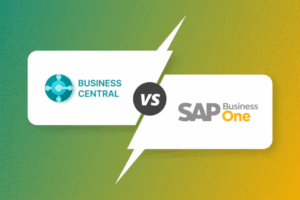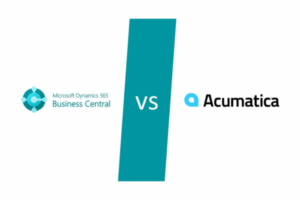Challenge 1: Unrealistic Business Central Implementation Timelines
The Problem: Many SMBs expect to be live in 2 to 3 months, even with 50+ users and multiple modules. In our research, fewer than 20% of SMB implementations finish in under three months, but over 60% plan for that.
Why it Happens: Vendors sometimes downplay timelines to win deals. Internally, leadership may also pressure teams to go live quickly.
How to Avoid It:
-
Use benchmarks by company size (most SMBs take 3 to 9 months).
-
Budget for the longer end of the range, then celebrate if you finish early.
-
Define milestones: finance go-live first, then operations, rather than a big-bang launch.
Mistake 2: Data Migration Problems in Business Central
The Problem: Data is messy. Old systems hold duplicate customers, incomplete records, or inconsistent formats. Many companies underestimate how long cleanup takes.
Real Example: A 60-user distributor we worked with expected data migration to take 2 weeks. It took 2 months because customer names were inconsistent across systems and inventory SKUs were duplicated.
How to Avoid It:
-
Start data cleanup before implementation begins.
-
Assign an internal “data champion.”
-
Use the 80/20 rule: migrate the data that matters, archive the rest.
Risk 3: Lack of Internal Ownership During Implementation
The Problem: Too often, companies think “the partner will handle it.” ERP projects fail without an internal champion.
Why it Matters: Partners bring expertise, but only you know your processes and people. Without someone driving decisions internally, projects stall.
How to Avoid It:
-
Appoint a project lead who can make decisions quickly.
-
Ensure executive sponsorship — leadership needs to be visible and engaged.
-
Free up 30 to 50% of the project lead’s time during implementation.
Problem 4: Scope Creep and Expanding Business Central Requirements
The Problem: Teams get excited and start adding custom reports, workflows, and modules mid-project. Suddenly, a 4-month plan becomes 9 months.
Original Insight: In our analysis, scope creep adds an average of 22% extra time and 18% extra cost to SMB Business Central projects.
How to Avoid It:
-
Separate “go-live essentials” from “phase two nice-to-haves.”
-
Lock requirements early and revisit add-ons later.
-
Remember: it is better to be live with 90% of what you need than stuck waiting for the last 10%.
Mistake 5: Training and Adoption Challenges in Business Central
The Problem: Even the best system fails if people do not use it. Training is often rushed or skipped to save time.
Real Example: A manufacturer went live smoothly on paper, but users kept defaulting to spreadsheets because they did not feel confident in the new system. Productivity actually dipped for months.
How to Avoid It:
-
Invest in role-based training (not just generic demos).
-
Schedule refreshers and Q&A sessions after go-live.
-
Appoint “super users” in each department as go-to resources.
Risk 6: Choosing the Wrong Business Central Partner
The Problem: Not all partners are equal. Some lack experience in your industry or oversell their capabilities.
Red Flag: If a partner says “yes” to everything without asking detailed questions, run.
How to Avoid It:
-
Ask for industry-specific references.
-
Evaluate methodology, not just price.
-
Look for transparency about risks, not just promises.
Challenge 7: Underestimating Change Management in Business Central
The Problem: ERP is not just software — it is a culture shift. People fear change, especially when processes and jobs are affected.
Why it Matters: Even with perfect technology, resistance can sink adoption.
How to Avoid It:
-
Communicate “why” the change is happening.
-
Involve employees early in workshops and testing.
-
Celebrate quick wins after go-live to build confidence.
FAQs: Business Central Implementation Risks and Challenges
How long does a Business Central implementation usually take?
Most SMBs take 3 to 9 months, depending on user count, modules, and data readiness. Smaller projects may finish in 2 to 3 months, while larger or multi-entity projects can take 12 months or more.
What is the biggest risk during implementation?
The single biggest risk is lack of internal ownership. Without a project champion, even the best partner and technology will struggle to succeed.
Do small businesses need a partner, or can they implement alone?
Technically, some very small companies have self-implemented. But the majority benefit from a partner’s expertise in setup, data migration, and training. For most SMBs, going without a partner increases risk significantly.
How much time should our team expect to commit?
Plan for your internal project lead to spend 30 to 50% of their time on the project during implementation. Department heads and end users should also expect to be involved in training and testing.
How can we avoid scope creep?
Define your must-haves before the project starts. Agree on a “phase two” list for nice-to-haves so they do not derail your go-live timeline.
Wrap Up
Business Central implementations do not fail because the software is bad — they fail because of poor planning, lack of ownership, or unrealistic expectations.
The good news: every one of these risks and challenges is avoidable. With clear timelines, clean data, strong internal leadership, and the right partner, your implementation can be a success story instead of a cautionary tale.
At Alchemy 365, we have seen both sides — the projects that soar and the ones that stumble. The difference is almost always preparation and ownership.
👉 Want to stack the odds in your favor? Download our ERP Fit Guide Checklist to see how ready your business is for implementation.





